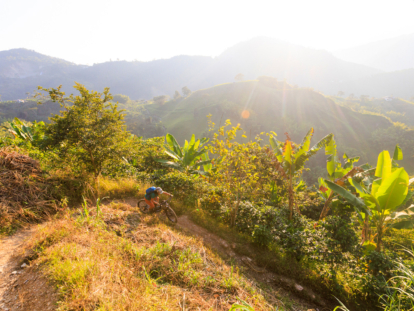Over-Roasted
Descending through Colombia’s coffee country, a crew of mountain bikers explores how climate change is impacting one of the world’s most cherished beverages and the lives of those who depend upon it.
Photos by Sofia Jaramillo
Wait. Don’t read this story yet. Instead, go make a cup of coffee. Brew it however you want. Have it black, or with sugar, cream or panela. Think about where it came from: a bush the size of a refrigerator, with green leaves and marble-sized oval fruits that turn red as they ripen. Picture the hands it passed through: on the farm, at the processing plant, at the roaster. Take a deep breath, then a sip.
Now, let’s begin.
We’re late, but Don Ramiro Ceballos still greets us with a smile of piano-key teeth as we shuffle into plastic chairs arranged around a small table. “Come in, come in!” he says, pointing to a jug of sugar water on the table. “We have aguapanela with lemon and some pasteles for you.”
Our bikes are lined up against the white wall of Ramiro’s house in Manizales, Colombia, caked in mud like a band of tired mechanical horses. We had just ridden (or in my case tumbled) down a trail known as La Garrucha, which is categorically not a mountain biking trail. It’s a path used by coffee pickers, sometimes with horses, to climb and scrape their way up the mountain—narrow, steep, rutted out and surrounded on all sides by thick green jungle.
After we’re settled, Ramiro gestures at the rows of head-high bushes outside. “We came here 20 years ago because the land is so healthy, so productive,” he says, referring to his modest 7-acre property spread across the steep hillside. This season, however, has been difficult; too much rain brought more pests and rot, and made the harvest schedule hard to predict. “There isn’t much we can do when it comes to bad weather, except ask El Señor to turn down the faucet a bit.”

Wax palms spot the steep hillsides and farms outside of Manizales. The tree—capable of reaching heights of up to 200 feet—is the world’s tallest palm and Colombia’s national tree, just one of the many unique species inhabiting the region’s precipitious high-elevation jungles.
Ramiro is one of more than 500,000 smallholder Colombian coffee farmers, known as cafeteros, that collectively grow nearly 10 percent of the world’s coffee. For nearly 200 years, coffee has meant jobs, schools, roads, safety and a source of pride for the people of this region. Now, a hotter and wetter climate is threatening the delicate balance of sun and rain that coffee plants need to flourish, putting Colombia’s cafeteros at risk.
Coffee is what brought the five of us—photographer Sofia Jaramillo, scientist-turned-athlete Emilé Zynobia, snowboarder and coffee entrepreneur Alex Yoder, filmmaker Jr Rodriguez and myself—to the country. Inspired by Sofia’s deep roots in the coffee trade, we’d decided to use mountain bikes to explore one of the Colombia’s defining industries, descending from the Andean alpine through the steep green hills of coffee country on dirt roads and singletrack. We’d end at Maracaibo, Sofia’s family’s cattle ranch, and along the way we’d talk to farmers like Ramiro and learn how climate change is impacting the region’s way of life.
“Other provinces had cocaine,” Don Jaime Eduardo Gutierrez, a coffee farmer from Manizales, had told us a few days earlier. “But not us. We’re proud that we looked to coffee for our existence.”
After one sip, we can tell Ramiro’s coffee is good—enough that Alex, who owns Overview Coffee, asks to buy a kilo of unroasted beans to take back to the US. Ramiro is crestfallen; he doesn’t have any unroasted beans at the moment, he explains, but will try to get us a bag before we leave.
Ramiro’s 10-year-old son, however, has an alternative. “We also sell guinea pigs!” he chirps, popping out from behind the door. “Do you want to buy one?”
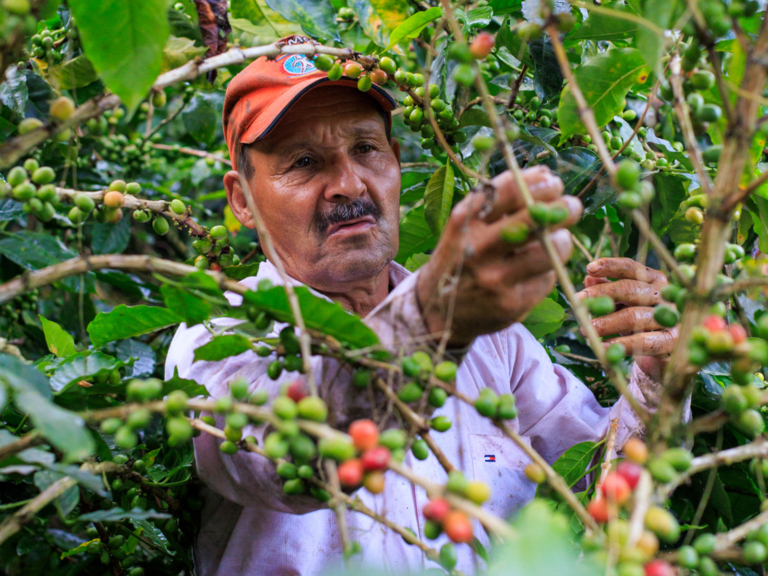
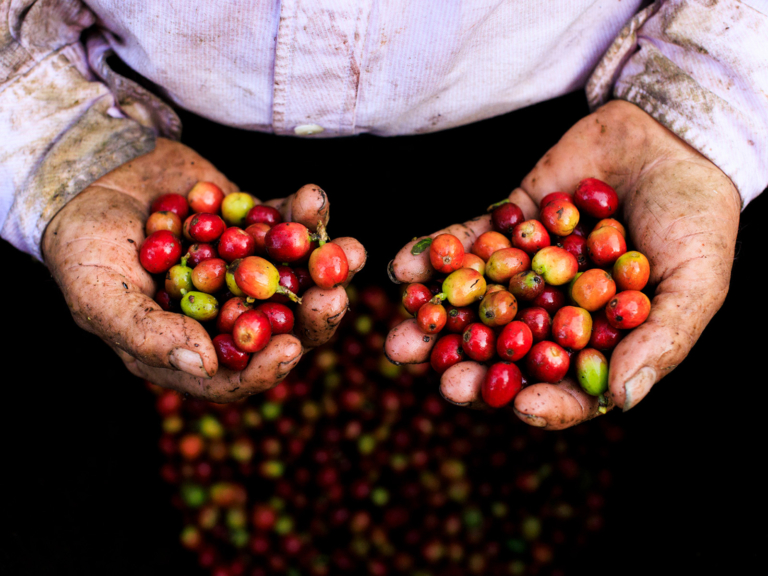
Historically, coffee farmers in Colombia harvest their crop twice a year, but erratic rain patterns have forced some to harvest through the entire year, picking berries as they ripen—meaning a single plant may have a mix of both green and red berries. Pedro Nicolás Valencia Garcia harvests a spectrum of color at Finca Portugal, a coffee farm outside of Manizales.
Our path to Ramiro’s farm began a few days earlier, along a dirt road some 13,000 feet above sea level, led by the descendant of coffee royalty. Sofia’s family has been involved in Colombian coffee since its beginnings: One of her great-great grandfathers, Antonio Pinzón, is credited with starting the first coffee farm in the Caldas region in 1878; his son, Carlos—known as “the King of Coffee”—is credited with growing the Colombian coffee industry to international renown; and one of her other great-grandfathers, Pedro Uribe Mejía, helped start the National Federation of Coffee Growers of Colombia, a 95-year-old nonprofit that promotes coffee production, among other services, both within the country and around the world. With the recent passing of her abuela, Sofia felt it was time to explore these roots.
Though not as foundational, our choice of transport is also deeply embedded in Colombian culture. Cycling is one of the country’s most popular sports—an abundance of steep roads and grueling, high-elevation climbs have bred world-class road racers for decades, including 2019 Tour de France champion Egan Bernal, one of the youngest to win the title in the race’s history. The Coffee Triangle’s extensive network of gravel roads and agricultural paths, some of which wind up into the Andean alpine, have also made it an increasingly popular destination for bike touring and, more recently, mountain biking.
It was this combination of bikes and coffee that brought us to the vast and rugged Andean páramo region, at the highest reaches of Colombian coffee country.
“This is where it all starts,” explained Juan Diego Giraldo Gómez, our guide for the trip. “The volcanic soil of the páramo is what makes the lower coffee lands so productive.”
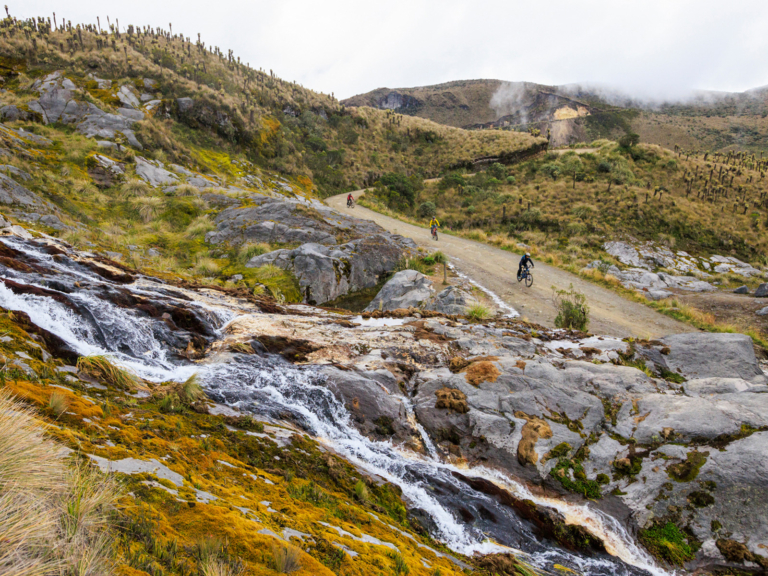
Alex Yoder, Lucas Isakowitz and Emilé (from left to right) ride past a waterfall just outside of Los Nevados National Park. Draped across some of the highest peaks of the Colombian Andes, the 144,000-acre park encompasses three of the country’s six remaining glaciers, numerous high-elevation wetlands and forests, and a variety of páramo ecosystems, all of which are a crucial source of water for the coffee farms, villages and cities below.
The páramo ecosystem is a high-altitude bog, found only in the Andean alpine of a few South American countries. The vegetation here serves as a giant sponge, storing rainwater and ice-melt in the soil, releasing it slowly and steadily throughout both wet and dry seasons, and making the páramo a vast reservoir that provides water for millions of Colombians—over 70 percent of the country’s population.
They’re also wildly biodiverse—over 80 percent of the plant species are endemic—and considered the world’s fastest evolving ecosystem. As we rode through this waterlogged system via dirt and gravel roads that curved around the mountain like a serpent, we passed through thickets of one such species that thrives in the páramos’ glacial and volcanic soils: frailejones, a towering plant with thick, water-filled trunks and tufts of green leaves and woolen flowers emerging from their heavy heads.
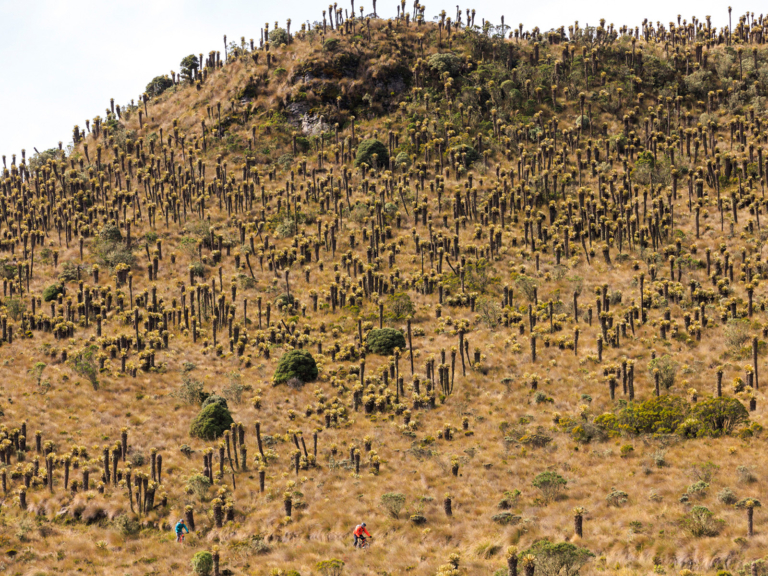
Despite their spikey appearance, frailejones actually belong to the same family as sunflowers and daisies, and many sport yellow, red or white flowers for much of the summer. They also grow exclusively in Andean páramos, creating an otherworldly alpine landscape for Lucas (left) and Alex (right).
Soon we left the frailejones and entered the jungle, riding under a canopy of leaves big enough to wrap up a mountain biker like a burrito. Hummingbirds flitted through the air, blue and orange and green and brown, as small as plums and as large as grapefruits. The páramo and surrounding jungle systems are biodiversity hotspots within what is already, by area, the most biodiverse country in the world. More than 56,000 species of plants and animals—including over 1,800 bird species—live in Colombia and make up close to 10 percent of the planet’s biodiversity. The páramos, with their carbon-rich soil, can also serve as buffers against climate change.
Yet these ecosystems are increasingly at risk. Animal agriculture is replacing natural systems at all elevations, including both the páramo and the once-extensive forest of towering wax palms. Gold, coal and other minerals are attracting mining companies to the páramo, and global temperatures are rising beyond even what such a rich and resilient ecosystem can handle.

Alex, Emilé and Lucas (left to right) pass the remains of a mudslide on a road outside of Manizales. Such slides are becoming increasingly common on the region’s dirt roads, as climate change intensifies extreme rainstorms that oversaturate the steep hillsides.
Climate change is also altering the country’s weather patterns, increasing the frequency and intensity of extreme rainfall events and droughts. We saw the impact that too much water can have on this steep terrain as we descended, where a massive mudslide had chewed through part of the mountain and left car-sized boulders in the middle of the road. Our guide Juan said that this year, it had rained double what it normally does in the Caldas province. A few days later, a cafetero would tell us the harvest is now year-round rather than twice a year—the wet and dry periods are so mixed up, the cherries are ripening off schedule.

Most of the trails around Manizales were made for workers traveling between banana plantations and coffee farms, and mountain bikers like Emilé often find riding the narrow, leaf-covered paths to be difficult … or, in some cases, terrifying.
None of this seemed to bother the little girl we rode past in the next village, who looked at Sofia and Emilé with wide eyes. “Mira, mira!” she yelled. “Those girls are riding big bikes!” The girl’s friend came out to watch Sofia and Emilé ride by, smiles emblazoned across their faces … until some dogs came rushing from behind a fence, barking and snapping at our ankles.
After descending over 8,000 feet, we were finally in the heart of coffee country.
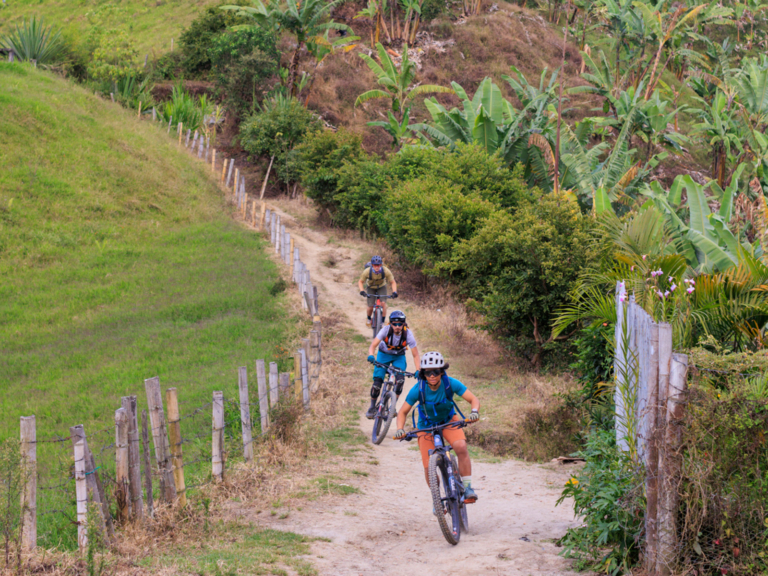
Emilé (front), Simón Arias Lasso (center) and the author (rear) emerge onto a dirt two-track after riding through a neighborhood just outside of Manizales. Simón is a co-founder of Trail Hunters, a Manizales-based tour company, and was our co-guide through the lower reaches of Colombia’s coffee country.
Jeferson Gonzales spends his days waging war against a bug the size of a pinhead: the coffee berry borer, an invasive species that first appeared in Colombia in the late 1980s. The 22-year-old Venezuelan works his way through the Hacienda Venecia coffee farm’s nearly 400 acres, one plant at a time, using a knife to cut open individual cherries to check if they’re infected.
“See, here is one,” he says, holding up a cherry with a rotted-out bean, and picks out a little black speck. This information helps Hacienda Venecia decide where and when to fumigate with pesticides, the method most commonly used by conventional farmers to control the coffee berry borer.
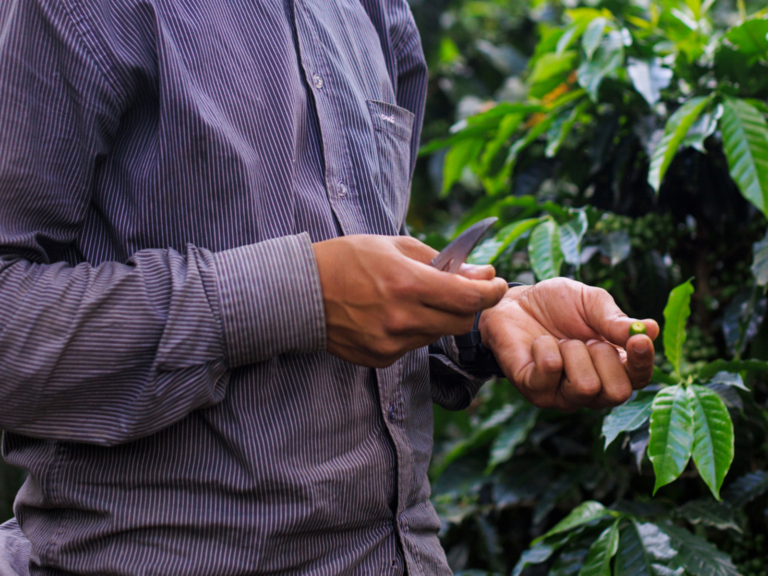
Jeferson Gonzales moved to Colombia from Venezuela in 2018, and now spends his days checking coffee plants for the invasive coffee berry borer. Jeferson makes as much in one day here as he would in two weeks in Venezuela and sends much of what he earns back to his family. “I want to see my parents, my little brothers and sister, but if I go to Venezuela, who will help them? I am the oldest son and so they have my help.”
Jeferson speaks of cultivating healthy coffee plants with a fluency that hides his newness to coffee farming. He and his wife emigrated to Colombia from Venezuela in 2018, leaving behind his parents and younger siblings. He has been working here ever since.
“Back in Venezuela we drink coffee, but I didn’t know anything about growing coffee or being a cafetero,” he says. “Now that I’ve been here for four years, coffee has become a huge part of my existence.”
This is perhaps coffee’s greatest contribution to the region: employment. About 500,000 Colombian campesinos make their living growing coffee, and 95 percent of Colombia’s coffee farms are smaller than 12 acres. Include those who transport, roast, market and export that coffee and the number of people supported by the crop grows even larger. Hacienda Venecia employs 50 people year-round to care for the plants and about 400 people during harvest season.
“What coffee means is lots of work,” says Pedro Nicolás Valencia Garcia, a coffee picker we talked to at a nearby farm. “Coffee gives campesinos the ability to make a living picking coffee.”
In this context, Jeferson’s battle against the coffee berry borer grows in significance. The tiny insect is considered the most harmful pest in most coffee-producing countries. It can feed exclusively on coffee beans and, if left uncontrolled, could wipe out an entire region’s crops.
Climate change is anticipated to make the situation worse. As temperatures warm, the beetle’s habitat extends to higher elevations. Coffee used to grow anywhere above 2,900 feet, but as heat and pests have moved upward, farms below 3,600 feet are becoming harder to find. One study suggests that, with an increase of 1.8 degrees Fahrenheit, farmers will have to move about 550 feet higher to maintain their current level of productivity and quality. The slow upward migration can leave smaller farms and farmers behind.
“The farmers you really want to talk to, they’re gone,” Don Jaime Eduardo Gutierrez told us on the first day of our trip, explaining how lower elevation farms have shifted out of production.
Still, an abundance of high-elevation and volcanic soils means that Colombia will continue to produce coffee, even in a hotter world—if farmers can find a way to prepare against coming changes and still make a living in a tough industry.
For Don Ramiro Ceballos, climate change is a threat insomuch as it impacts his ability to pay the bills. His farm produces around 1,650 pounds of coffee annually, which—depending on the wholesale price of coffee—brings in between $2,000 and $3,000 USD. “I worry about too much rain, but my greatest worry is about finding good farmhands, good workers and, of course, the price of coffee,” he told us when we visited his farm. “At the end of the day, coffee means work and money for us.”

As the capital of the Department of Caldas, Manizales is in the heart of Colombia’s coffee-growing region, a bustling city of some 430,000 people that’s surrounded by steep farms, thick jungle and an increasingly well-known trail system. Photo: Sofia Jaramillo
A few decades ago, a handful of ambitious cyclists realized the steep hillsides around Manizales, so ideal for coffee, plátano and avocado farming, could also prove ideal for mountain biking: so ideal, in fact, that the nearby trails and agricultural paths have since hosted numerous national championships and produced South America’s most decorated downhiller racer, Marcelo Gutierrez. In 2018, the city even hosted a stop of the Enduro World Series, an event that kicked off with a high-speed urban descent through Manizales streets and back alleys.
Manizales’ trails have also birthed numerous mountain bike tour companies (such as Kumanday Adventures, which our guide Juan Diego Giraldo Gómez co-founded) which lead customers on rides around the city and along the steep dirt roads linking remote areas of the mountains. These days, enough cyclists pass through the remote villages and fincas, many inaccessible by car, that locals have started catering to them. “I call this entire thing the new bicycle economy,” says Simón Arias Lasso, our co-guide through the lower coffee regions. “People create stands on weekends to sell orange juice, lunch and coffee.”
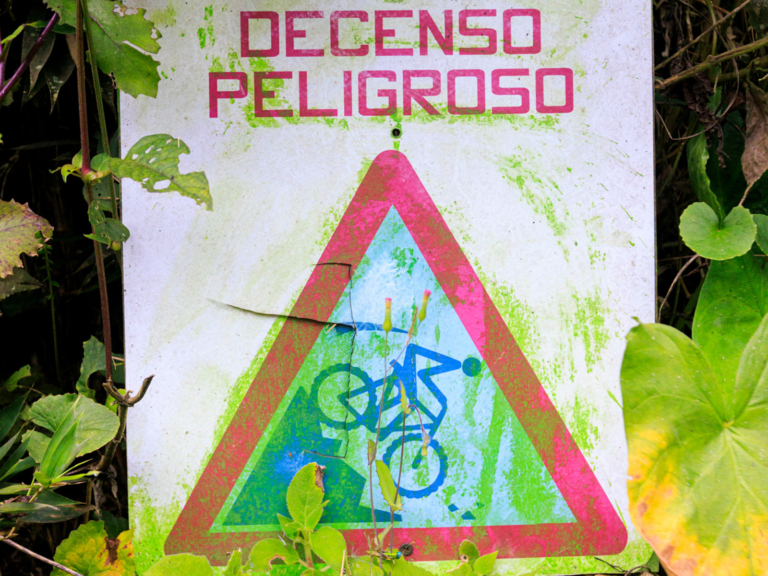
An old sign emerges from the flora of a sugarcane plantation, evidence of a mountain bike race held in the area years before. These days the trail is mostly frequented by campesinos, and occasionally by mountain bikers looking for a wild ride. Photo: Sofia Jaramillo
We stopped for a quick coffee and some bocadillo de guayaba—energy chews made of guava paste—at a roadside shop in the village of Neira, then pedaled through a residential area until we found a turnoff that went straight down. These steep dirt tracks serve as transportation veins between farms and villages, so it wasn’t surprising to find this one blocked by two horses.
“Just don’t ride too close and you’ll be OK,” Simón told us as we wove past the horses, who seemed wholly unbothered by our presence.
The trail quickly narrowed into singletrack, split by a big rut from the recent rains, before crossing into a mix of coffee and sugarcane plantations. As we entered the sugarcane fields, we heard a distant, rhythmic boom, hiss, clack. Without warning, an invasion of dogs darted out from the brush, yapping, yipping and nipping at our ankles. We yelled and growled, trying to keep our legs high and out of danger as we pedaled away.
The boom, hiss, clack grew in volume as we moved deeper into the sugarcane, until we finally came to its source. Inside two modest concrete buildings, a group of men were making panela, a type of unrefined sugar made from boiled sugarcane juice that’s often used to sweeten coffee in Colombia.
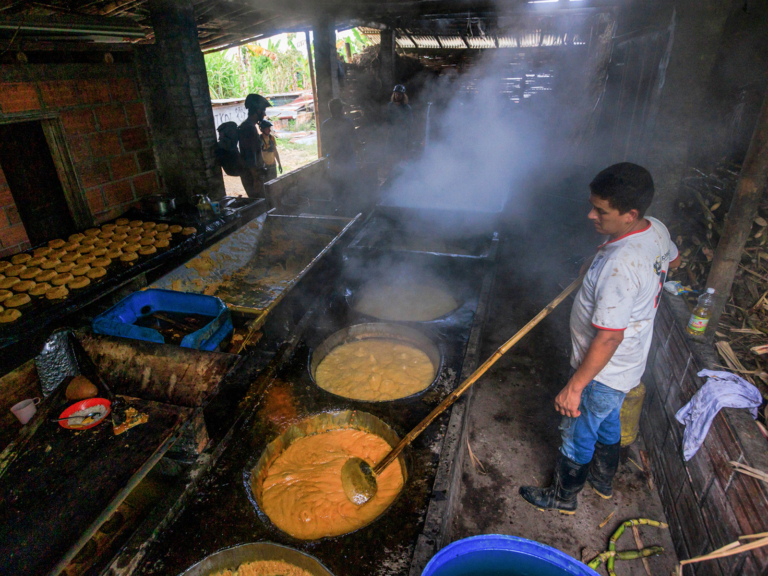
Making panela is hard work, as the crew discovered when they stumbled on a small production facility in the middle of a sugarcane field. Colombians consume enough panela to support 20,000 similar operations across the country; the owner of this one, Don Oscar, has been practicing the trade for 40 years, and passed the skill down to his son, Oscar Jr. (in white).
The operation’s owner, Don Oscar, sat in a chair next to the bubbling sugarcane, with a pitchfork in both hands and a cigarette in his mouth. He’d been at this work for 40 years, and as he shoved dried husk into a fire below the bubbling caldron, he told us farmworkers drink panela with their coffee because they need energy to get through the workday. Another coffee farmer told us that panela is used to sweeten coffee because all the high-quality beans are shipped overseas, leaving only the worst, spit-out-bitter coffee for domestic consumption. The gap between farming coffee and drinking coffee is wide.
Before we left, Oscar’s son, Oscar Jr., handed us four fresh panela bricks and told us to come back any time. As we jumped back on our bikes, someone said that this was the hardest work they’d ever seen. We answered with silence, hot panela steaming in our backpacks as the rhythmic boom, hiss, clack followed us into the jungle.
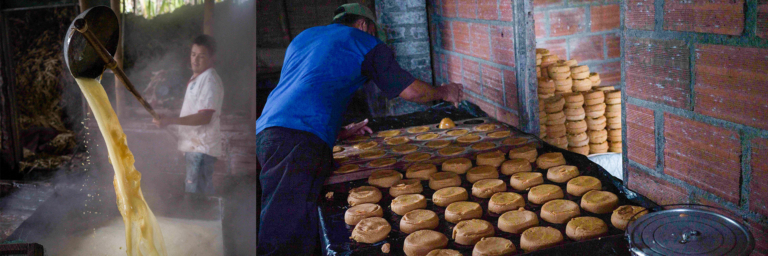
Panela is often used to make a sweet coffee drink called café campesino, which is how most coffee is served in the Colombian countryside. Oscar Jr. (left) stirs bubbling cane juice; when it thickens, it will be shaped into dense bricks and laid out to cool (right). Photos: Alex Yoder
After another seemingly endless descent, we came across another example of Simón’s “new bicycle economy:” a small house with a sign advertising snacks for sale. An old lady and a little girl poked their heads out of the window. What did we want? Soda, cookies and cigarettes, please.
The old lady came out, bearing the bundle of goods. Her name is Doña Socorro Marin, and she has lived in the area for a few decades. As more and more bikers came down this route, she set up her little shop to sell goods as people passed. She swore that she had seen us before and asked us when we would be back. We said we hoped to be back soon. She told us to be careful of the dogs.
Forget the road less traveled. The best road is the one worn thin by the locals.
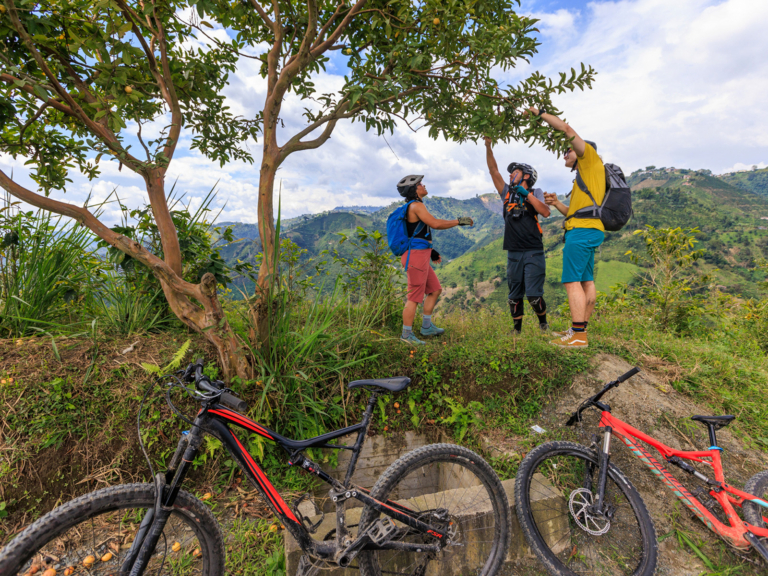
Colombia is home to a wide variety of tropical fruits, which make for thirst-quenching trailside snacks. Simón (center), Emilé (left) and Lucas (right) stock up on guavas while riding outside of Manizales.
La Esperanza, which literally translates “the hope,” is the last finca we visited and a model for what the future of sustainable coffee farming could look like. From a distance, the 50-acre property looks to be wild jungle, but under the canopy of most of the trees are clusters of shade-grown coffee plants. “Like hens protecting their chickies,” explains Don Hernan Perez, La Esperanza’s owner.
Hernan is tall and lanky, with soft eyes and big hands that flitter like birds as he talks. Ten years ago, Hernan began the transition to a fully regenerative operation, using farming practices that prioritize soil and water health, sequestering more carbon than traditional coffee farming. It’s the type of coffee that Alex aims to sell through Overview and that will earn top dollar from similar high-end retailers on the international market. “Philosophy and economy are mixed here,” Hernan tells us. “Philosophy because we want to be ecological; economy because we have to pay the bills.”
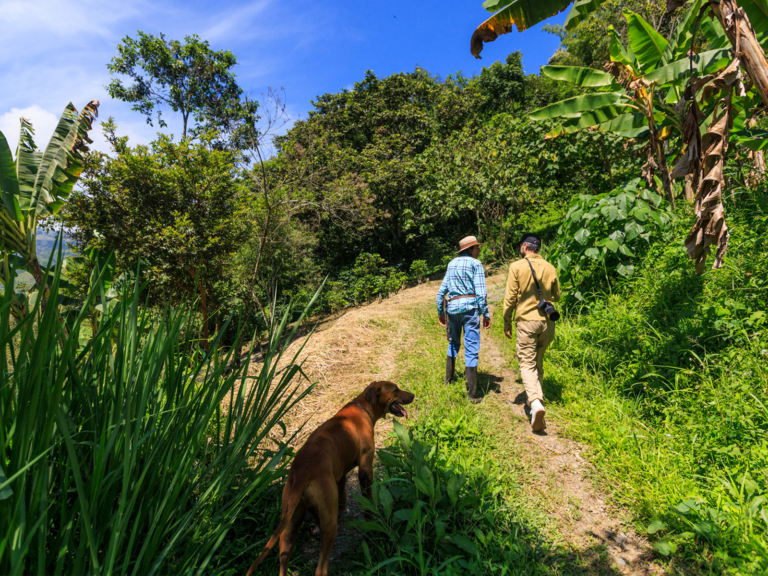
Don Hernan Perez (left) shows Alex (right) around La Esperanza, pointing out the clusters of coffee plants tucked in the cooling shade of the tree canopy “like hens protecting their chickies,” he says. Chocolate, Hernan’s Rhodesian Ridgeback, trails behind.
Hernan’s father-in-law never cut down the trees on the property, opting to grow shade-grown coffee varieties, which helped with the farm’s transition to a regenerative operation. But the first few years were still very hard, with plants producing fewer beans as if in withdrawal from chemical herbicides and fertilizers. Now that things have stabilized, and as more diversity comes onto the property, natural predators of the coffee beetle borer have all but eliminated the pest without the use of chemicals. “If we had coffee and only coffee, there is only habitat for the things that live with the coffee or live from the coffee, and so that is why you have pests,” he said. “But in the natural forest, you don’t find too many sick plants because there is equilibrium.”
Hernan’s current focus is on cultivating wildness. “The property is so healthy that even the elves have come back,” he says half-jokingly, adding that the magical jungle creatures don’t like pesticides either.
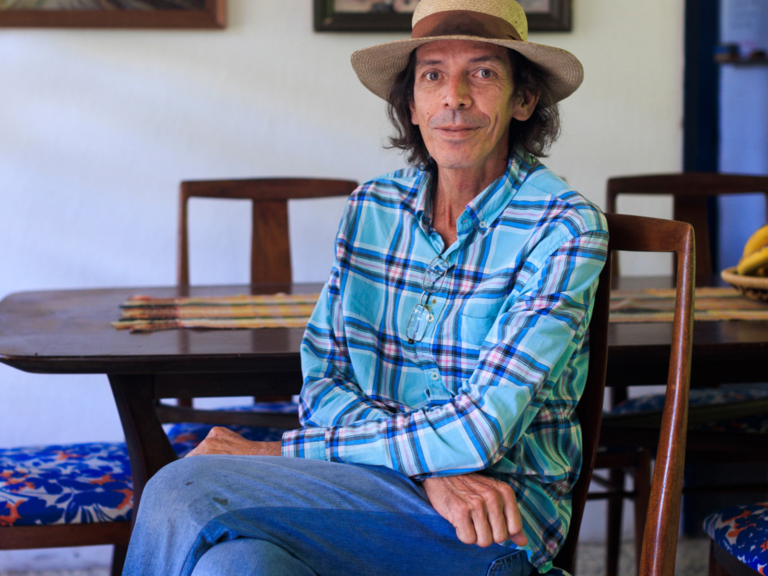
Hernan’s coffee farm, La Esperanza, literally translates to “the hope” and is a thriving example of the possibilities of Regenerative Organic agriculture: shade-grown coffee with no chemical inputs, on a farm prepared to withstand rising temperatures. Photo: Sofia Jaramillo
This diverse jungle, with an army of creatures ready to fight off pests and tree canopies to shade coffee plants from the sun, will help prepare his farm for the coming challenges of climate change. But while he wishes every farmer could do what he’s doing, he admits it’s difficult. The economics are hard, with an initial drop in income over the first few years. Now that he’s made the switch, he’s working to sell his coffee—marketed as Café Don Gabriel—directly to high-end retailers like Overview who will pay more, but that requires connections to diverse markets that many rural cafeteros don’t have. For many farmers, the divide between conventional and regenerative production is so wide that transitioning would require large amounts of financial and technical support.
And herein lies the wickedness of adaptation: Preparing for climate change requires the luxury of looking past the problems of today and looking forward to 10, 20 or 30 years into the future.
As we leave, Hernan tells us to make sure we ask the elves for permission as we ride through the jungle or else we might get a flat.
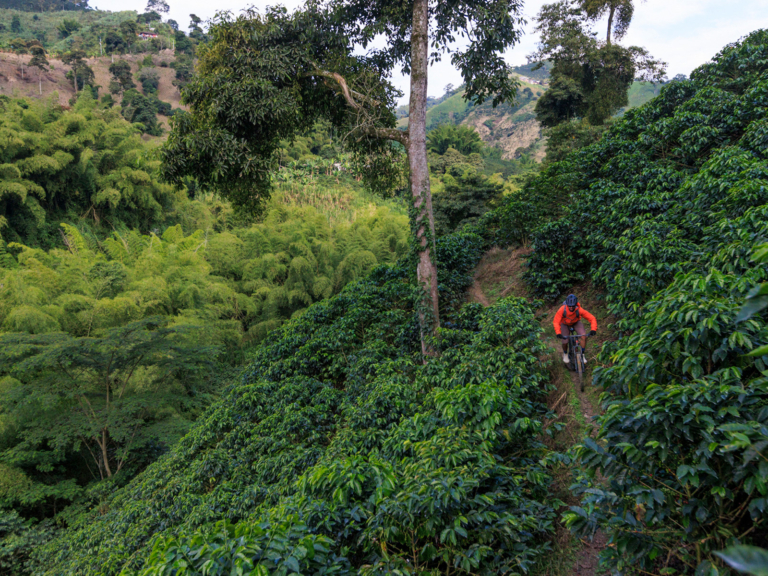
Alongside his roles as professional snowboarder and activist, Alex is also an entrepreneur. In 2018, he founded Overview Coffee to help small coffee producers transition their farms to Regenerative Organic agriculture, which will earn them more on the global market.
Our last day of biking was hard. We rode from La Esperanza along dusty dirt and concrete roads toward Maracaibo, Sofia’s family’s cattle ranch. During our week biking through one of the rainiest zones on the planet, we’d used our rain jackets just once. “My uncle said we haven’t had a week this dry in six months,” says Sofia. “I feel like my abuela was looking out for us, making sure we didn’t get totally soaked.”
As we rode, the jungle seemed to disentangle itself. Vines unwrapped from limbs, canopy opened into blue sky, and the feeling of sweat, dirt, work and bugs cleared away into an image of coffee production that none of us had seen at the start of the trip. In every cup, there exists a tension between romance—delicious smells, lush-green leaves, hovering hummingbirds and even jungle elves—and the rawness of barely-scraping-by coffee farmers, invasive coffee-plant-devouring pests and a life occupied with a cycle of hard labor.
As we were pedaling, we saw someone on the side of the road waving us down. It was Ramiro, his smile as big as ever, with a kilo of green unroasted beans in his hand. He gave the bag to Alex, who would take that coffee back to his roaster in Jackson Hole to see if he can create a product that would turn US dollars into a direct, meaningful income for a coffee farmer like Ramiro.
“Come back during harvest season,” Ramiro said. “And tell others to come!”
Editor’s Note: All opinions expressed here are that of the author, and do not represent that of any employer or other organization.
